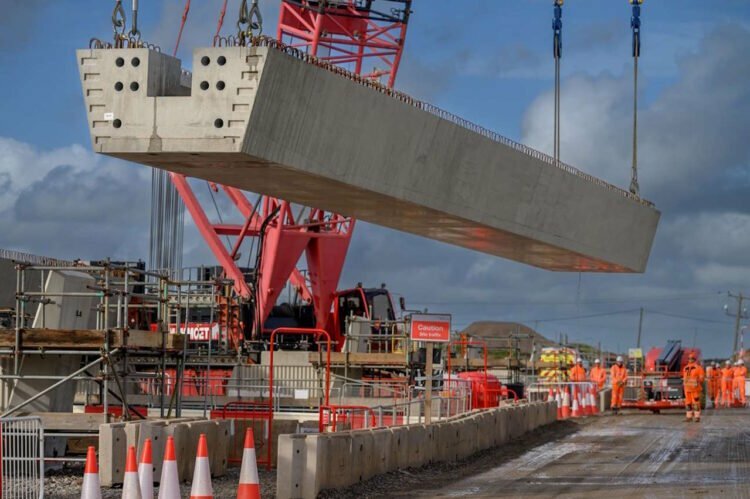Multiple HS2 sites are to make use of a brand new digital monitoring system for concrete which aims to dramatically reduce wasted materials and lower carbon emissions during construction.
The new technology, VERIFI, has been developed by Saint Gobain Construction Chemicals, along with their concrete production partners, Tarmac and Aggregate Industries, and will be used by Balfour Beatty VINCI, the primary contractor on HS2 sites across the country.
Despite the cancellation of large sections of the HS2 line, construction work continues in areas across the South of England. Recently, a series of large concrete beams were installed as part of a viaduct across a flood plain near Aylesbury to allow HS2 to operate through the area during all weathers.

VERIFI uses digital technology to provide constant monitoring of concrete within mixer trucks throughout the process of delivering and pouring fresh concrete. Information on both the temperature and consistency, or slump, of the concrete can be provided to construction workers without the need for manual tests.
Having access to VERIFI’s constant digital monitoring system is expected to reduce the amount of concrete that is wasted. It is anticipated that use of the system along Balfour Beatty VINCI’s stretch of HS2 track will reduce carbon emissions by as much as 1,500 tonnes.
Tests of the new technology were conducted in the production of over 20,000 cubic metres of concrete, during which it was proven that VERIFI was able to provide a high level of accuracy.
In addition to the reduction of waste and carbon emissions, the new system will also provide a greater level of safety for workers, as manual concrete tests will no longer be required, reducing the need for workers to come into direct contact with fresh concrete during testing.
There is also the potential for the new technology to increase efficiency and speed for construction at HS2 sites, as manual testing can also cause delays to the use of concrete.
VERIFI also allows for the use of GPS data when tracking the movement of concrete mixing trucks, which should further aid logistics surrounding the timely delivery of materials to various sites across the HS2 line.
This is not the only new technological innovation in concrete construction to come in recent years. In 2021, Network Rail used laser mapping technology to pour concrete underwater in the Carlisle area of the West Coast mainline.
Jon Knights, the Materials and Durability Lead for HS2, said of the new VERIFI technology:
“This is a fantastic example of how HS2, working collaboratively with supply chain partners, can provide the ideal testbed for cutting-edge technologies. As the UK’s largest infrastructure project, it’s a great step forward for HS2 Ltd to formally supplement this digital surveillance technology with manual consistence and temperature testing of fresh concrete to reduce waste and increase safety and productivity.
“We have set big ambitions to drastically cut carbon as we build HS2, and digital surveillance solutions support us on this journey, not only bringing multiple benefits to the project, but paving the way for a new era in the construction industry.”
These words were echoed by Balfour Beatty VINCI’s Steve Phipps, who said:
“The initial concept of using this technology to reduce manual testing has been developed into a fully integrated digital monitoring and reporting system between producer and customer.
“It’s very rewarding to have finally implemented this digital solution after a process of trials, validation and approvals, made possible by great teamwork. Now that implementation is underway across our HS2 sites in the Midlands, we will start to see the significant benefits.”
Saint Gobain Construction Chemicals’s EVP Frederic Guimbal said:
“We’re delighted that the adoption of VERIFI represents a significant step forward for the HS2 project, bringing tangible benefits in terms of quality control, productivity, safety, sustainability, planning, reliability, and digitisation.
“This innovative solution demonstrates the power of collaboration and paves the way for the integration of digital methods in future concrete standards across the construction industry.”
According to Tarmac’s HS2 Technical & Quality Manager, Ryan Griffith:
“The concrete industry is truly modernising. The carbon benefits and transparency from plant to pour are now a reality with the acceptance of VERIFI digital consistency measurements for the concrete we supply for the construction of HS2.
“Having worked closely with BBV and VERIFI on implementing this technology, it is a huge step forward to have a complete digital concrete quality system that is improving outcomes for customers.”
Aggregate Industries’ Joseph Hartley added:
“Working with VERIFI is a monumental step change in supplying quality assured concrete to our customers. The visibility it gives to ourselves and to our clients is unprecedented. The ability to monitor, maintain our product and track vehicle movements allows significant environmental and cost benefits for us and HS2.
“We have been able to work closely to BBV and the VERIFI team to fully understand VERIFI and get the maximum out of the system giving us the opportunity to collaborate with everyone on the project. Having worked in the ready-mixed concrete business for 36 years, VERIFI is one of the most significant upgrades to our operational capability I’ve seen.”






Responses